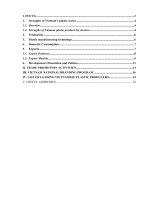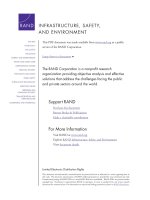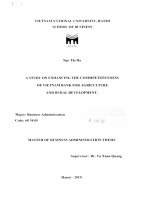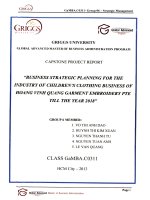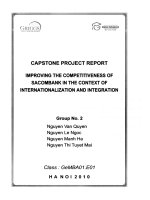INVESTIGATING THE COMPETITIVENESS OF VIETNAM’S AGRICULTURAL SECTOR: A MULTI-LEVEL APPROACH
Bạn đang xem bản rút gọn của tài liệu. Xem và tải ngay bản đầy đủ của tài liệu tại đây (5.27 MB, 266 trang )
MINISTRY OF EDUCATION AND TRAINING
UNIVERSITY OF ECONOMICS HO CHI MINH CITY
*******
HOÀNG VĂN VIỆT
INVESTIGATING THE COMPETITIVENESS OF
VIETNAM’S AGRICULTURAL SECTOR: A
MULTI-LEVEL APPROACH
DOCTOR OF PHILOSOPHY DISSERTATION
Ho Chi Minh City, December 2017
Viết thuê luận văn thạc sĩ, luận án tiến sĩ
Mail :
Phone: 0972.162.399
MINISTRY OF EDUCATION AND TRAINING
UNIVERSITY OF ECONOMICS HO CHI MINH CITY
*******
HOÀNG VĂN VIỆT
INVESTIGATING THE COMPETITIVENESS OF
VIETNAM’S AGRICULTURAL SECTOR: A
MULTI-LEVEL APPROACH
Major: Doctor Dissertation on Development Economics
Code: 62310105
ACADEMIC ADVISERS:
1. Assoc. Prof. Dr. Trần Tiến Khai
2. Assoc. Prof. Dr. Từ Văn Bình
A dissertation submitted to the University of Economics Ho Chi Minh City for
the degree of DOCTOR OF PHILOSOPHY
Ho Chi Minh City, December 2017
Viết thuê luận văn thạc sĩ, luận án tiến sĩ
Mail :
Phone: 0972.162.399
This dissertation is dedicated to the memory of my father-Hoàng
Văn Thọ, to my mother-Trần Thị Sang, and to my daughterHoàng Nguyễn Minh Châu
“The more I study science, the more I believe in God”
-Albert Einstein-
Viết thuê luận văn thạc sĩ, luận án tiến sĩ
Mail :
Phone: 0972.162.399
ACKNOWLEDGEMENT
First of all, I would like to express my best gratitude to Prof. Trần Tiến Khai, Prof.
Matthew Gorton, and Prof. Carmen Hubbard. Prof. Trần Tiến Khai brings me in the
research career with the initial lesson, advice, and passion. Prof. Matthew Gorton and
Prof. Carmen Hubbard raise me up to the international research standards with the
advice, the lesson, and the research cooperation opportunities.
Second, I am deeply thankful to my teachers: Dr. Phạm Khánh Nam, Prof. Nguyễn
Trọng Hoài, Prof. Lionel Hubbard, Prof. Peter Goldsmith, Prof. Từ Văn Bình, Dr.
Trương Đăng Thụy, and Prof. Nguyễn Ngọc Vinh for the lessons, guides, and advice.
Third, I am really indebted to my colleagues: Mr. Nguyễn Khánh Duy, Ms. Nguyễn
Quỳnh An, Ms. Nguyễn Hồng Mai, Ms. Nguyễn Phan Trúc Phương, and Mr. Hồ Minh
Chí. They contribute the important parts to my achievement of this dissertation.
Especially, I would express my gratitude and respect to Prof. Nguyễn Đông Phong
who indirectly empower me with the strategic and excellent policies for young lecturers.
Moreover, I am thankful to the board of professors, the independent reviewers, journal
editorial boards, and journal reviewers for their constructive reviewing and comments.
I am wholeheartedly grateful to my family for their love, trust, support, sharing, and
encouragement. This dissertation would be never completed without them.
Ho Chi Minh City, December 2017
Hoàng Văn Việt
Viết thuê luận văn thạc sĩ, luận án tiến sĩ
Mail :
Phone: 0972.162.399
DECLARATION
I, Hoàng Văn Việt, declare that the PhD dissertation entitled “Investigating and
Comparing the Agricultural Competitiveness of Vietnam” strictly conforms to the
regulations and the rules of Ministry of Education and Training and the University of
Economics Ho Chi Minh City. This dissertation contains no material that has been
submitted previously, in whole or in part, for the award of any other academic degree or
diploma. Except where otherwise indicated, this dissertation is my own work.
Ho Chi Minh City, December, 2017
Hoàng Văn Việt
Viết thuê luận văn thạc sĩ, luận án tiến sĩ
Mail :
Phone: 0972.162.399
i
TABLE OF CONTENTS
LIST OF TABLES ............................................................................................................. v
LIST OF FIGURES ........................................................................................................ vii
LIST OF APPENDICES ................................................................................................ viii
LIST OF ABBREVIATIONS ............................................................................................ x
CHAPTER 1: INTRODUCTION...................................................................................... 1
1.1. Background .......................................................................................................... 1
1.2. Research gap identification .................................................................................. 6
1.3. Research objectives and questions ....................................................................... 9
1.4. Brief of research methodology, scope, and data ................................................ 12
1.5. Expected significance and contribution ............................................................. 14
1.6. The structure and outline of the dissertation ...................................................... 16
CHAPTER 2: LITERATURE REVIEW......................................................................... 18
2.1
Definition of competitiveness ............................................................................ 18
2.2
Evolution of competitiveness theory .................................................................. 23
2.3
Frameworks of competitiveness ......................................................................... 34
2.3.1
Economic and production indicators ........................................................... 36
2.3.2
Trade performance indices .......................................................................... 47
2.4
Summary and the general framework of the dissertation................................... 56
CHAPTER 3: RESEARCH METHODOLOGY AND DATA ....................................... 60
3.1
The trade performance indices ........................................................................... 60
3.1.1
Revealed comparative advantage (RCA) .................................................... 60
3.1.2
Relative trade advantage (RTA) .................................................................. 61
Viết thuê luận văn thạc sĩ, luận án tiến sĩ
Mail :
Phone: 0972.162.399
ii
3.1.3
Normalized revealed comparative advantage (NRCA) ............................... 62
3.1.4
Dynamics of comparative advantage indicators .......................................... 64
3.1.5
Complementarity and substitutability analysis ............................................ 68
3.1.6
Consistency analysis .................................................................................... 70
3.1.7
The data for the trade performance indices ................................................. 71
3.2
The economic and production indicators in the PAM model ............................ 72
3.2.1
Private profitability (PP - D) ....................................................................... 73
3.2.2
Private cost ratio (PCR) ............................................................................... 74
3.2.3
Social profitability (SP - H) ......................................................................... 74
3.2.4
Domestic resource cost (DRC) .................................................................... 75
3.2.5
Social cost-benefit (SCB) ............................................................................ 75
3.2.6
Nominal protection coefficient (NPC) ........................................................ 76
3.2.7
Effective protection coefficient (EPC) ........................................................ 77
3.2.8
Profitability coefficient (PC) ....................................................................... 77
3.2.9
Subsidy ratio to producers (SRP) ................................................................ 77
3.2.10
The data and estimations for the PAM indicators .................................... 77
3.2.11
Sensitivity analysis of the PAM indicators .............................................. 83
CHAPTER 4: VIETNAM’S AGRICULTURAL TRADE COMPETITIVENESS: THE
CROSS-SECTIONS ANALYSIS .................................................................................... 85
4.1
Vietnam’s agricultural trade competitiveness by the RCA ................................ 85
4.1.1
Measuring the static competitiveness .......................................................... 85
4.1.2
Analyzing the dynamics of the competitiveness indicators ........................ 87
4.2
Vietnam’s agricultural trade competitiveness by the RTA ................................ 91
Viết thuê luận văn thạc sĩ, luận án tiến sĩ
Mail :
Phone: 0972.162.399
iii
4.2.1
Measuring the static competitiveness .......................................................... 91
4.2.2
Analyzing the dynamics of the RTA indicators .......................................... 92
4.3
Vietnam’s agricultural trade competitiveness by the NRCA ............................. 96
4.3.1
Measuring the static competitiveness .......................................................... 96
4.3.2
Analyzing the dynamics of of the NRCA indicators ................................... 98
4.4
The consistencies of the trade performance indices: sector-ranking ............... 101
CHAPTER 5: THE ASEAN COUNTRIES’ AGRICULTURAL TRADE PATTERNS:
THE CROSS-COUNTRIES ANALYSIS ..................................................................... 103
5.1
The agricultural international trade performance of ASEAN countries .......... 104
5.1.1
Agricultural competitiveness by the RCA ................................................. 104
5.1.2
Agricultural competitiveness by the RTA ................................................. 106
5.1.3
Agricultural competitiveness by NRCA index .......................................... 107
5.1.4
Analyzing the dynamics of agricultural competitiveness indicators ......... 109
5.2
The trade agricultural complementarity of the ASEAN countries ................... 111
5.2.1
The agricultural trade complementarity of the ASEAN countries ............ 111
5.2.2
The agricultural export similarity of the ASEAN countries...................... 113
5.2.3
The agricultural complementarity by Spearman coefficients.................... 114
5.2.4
The impact of external markets and factors .............................................. 117
5.3
The consistencies of the trade performance indices: country-ranking ............. 119
CHAPTER 6: THE COMPETITIVENESS OF ALTERNATIVE AGRICULTURAL
CROPS: A CASE STUDY OF BEN TRE..................................................................... 121
6.1
Measuring the comparative advantage of the alternative crops ....................... 122
6.1.1
The comparative advantage of rice............................................................ 122
Viết thuê luận văn thạc sĩ, luận án tiến sĩ
Mail :
Phone: 0972.162.399
iv
6.1.2
The comparative advantage of coconut ..................................................... 125
6.1.3
The comparative advantage of pomelo...................................................... 128
6.2
Indicators and sectors consistency and comparison analysis ........................... 130
6.3
Sensitive analysis of the comparative advantage indicators ............................ 134
6.3.1
Climate changes ......................................................................................... 134
6.3.2
Water and land charges ............................................................................. 135
6.3.3
The parameters of assuming changes of the variables .............................. 136
CHAPTER 7: CONCLUSION AND IMPLICATIONS ............................................... 139
7.1
Vietnam’s agricultural trade competitiveness .................................................. 139
7.2
The ASEAN countries’ agricultural trade patterns .......................................... 141
7.3
Competitiveness of alternative agricultural production systems in Ben Tre ... 143
7.4
Theoretical analysis and conclusion ................................................................. 146
7.5
Policy implications ........................................................................................... 148
Re-structuring the agricultural production and trade pattern ................................. 149
Maintaining the rankings of strong competitiveness sectors ................................. 150
Expanding and enforcing the regional and global integration ............................... 151
Building the agricultural production master plans ................................................. 152
Promoting sustainable agriculture and adapting to climate changes ...................... 153
LIST OF MY PUBLICATIONS & PROJECTS ............................................................... 1
LIST OF REFERENCES ................................................................................................... 4
APPENDICES ................................................................................................................. 29
Viết thuê luận văn thạc sĩ, luận án tiến sĩ
Mail :
Phone: 0972.162.399
v
LIST OF TABLES
Table 2-1: The evolution of competitiveness theory ........................................................ 33
Table 2-2: The measures of competitiveness by level of analysis ................................... 35
Table 3-1: The accounting structure of policy analysis matrix ....................................... 73
Table 3-2: Sample descriptions for the PAM indicators ................................................. 79
Table 4-1: Vietnam’s top agricultural competitiveness by the RCA ............................... 86
Table 4-2: The change of the RCA indicators position between 1997 and 2014 ............ 87
Table 4-3: The OLS estimation results for the RCA indicators over three periods ........ 88
Table 4-4: The classifications of RCA values and the interpretations ............................ 89
Table 4-5: The M-Shorrocks and Markov transition matrix for the RCA values ............ 89
Table 4-6: The top gaining and losing trends of the RCA indicators .............................. 90
Table 4-7: Vietnam’s top agricultural competitiveness by the RTA ................................ 92
Table 4-8: The changes of the RTA indicator ranks between 1997 and 2014 ................. 93
Table 4-9: The OLS estimation results for the RTA indicators over three periods ......... 93
Table 4-10: The classification of the RTA values and the interpretations ...................... 94
Table 4-11: The M-Shorrocks and Markov transition matrix for the RTA values .......... 95
Table 4-12: The top gaining and losing trends of the RTA indicators ............................ 96
Table 4-13: Vietnam’s top agricultural trade competitiveness by the NRCA ................. 97
Table 4-14: The changes of the NRCA indicator ranks between 1997 and 2014 ........... 98
Table 4-15: The OLS estimation results for the NRCA indicators over time .................. 99
Table 4-16: The classification of the of NRCA values and the interpretations ............... 99
Table 4-17: The Markov transition probability matrix for the NRCA indicators ........... 99
Table 4-18: The top gaining and losing trends of the NRCA indicators ....................... 100
Table 4-19: The consistencies the RCA, the RTA, and the NRCA by sector-ranking ... 102
Table 5-1: The agricultural competitiveness of the ASEAN countries by the RCA ....... 105
Table 5-2: The number of strong agricultural competitive sectors by the RCA ............ 106
Table 5-3: The agricultural competitiveness of the ASEAN countries by the RTA ....... 107
Viết thuê luận văn thạc sĩ, luận án tiến sĩ
Mail :
Phone: 0972.162.399
vi
Table 5-4: The agricultural competitiveness of the ASEAN countries by the NRCA .... 108
Table 5-5: The agricultural competitiveness ranking of the ASEAN countries ............ 108
Table 5-6: The agricultural competitiveness patterns of the ASEAN countries ............ 110
Table 5-7: The Markov transition probability matrices result ...................................... 111
Table 5-8: The agricultural trade complementarity by the TCI .................................... 112
Table 5-9: The agricultural export similarities of the ASEAN countries ...................... 113
Table 5-10: The Spearman’s rank correlation coefficients of the RCA indicators ....... 115
Table 5-11: The Spearman’s rank correlation coefficients of the RTA indicators ....... 116
Table 5-12: The Spearman’s rank correlation coefficients of the NRCA indicators .... 116
Table 5-13: Mean coefficients of the consistency between trade indices ...................... 120
Table 6-1: Rice’s PAM summary and comparative advantage indicators (VND) ........ 124
Table 6-2: Rice’s comparative advantage by the trade indices .................................... 125
Table 6-3: Coconut’s PAM summary and comparative advantage indicators (VND).. 127
Table 6-4: Coconut’s comparative advantage by the trade indices .............................. 127
Table 6-5: Pomelo’s PAM summary and comparative advantage indicators (VND) ... 130
Table 6-6: Pomelo’s comparative advantage by the trade indices ............................... 130
Table 6-7: Comparing the competitiveness of different sectors by various indices ...... 133
Table 6-8: The comparative advantage indicators with the land opportunity cost ....... 134
Table 6-9: Sensitivity analysis of the PAM indicators by the climate change .............. 135
Table 6-10: Sensitivity analysis of the PAM indicators by water & land charges ........ 135
Viết thuê luận văn thạc sĩ, luận án tiến sĩ
Mail :
Phone: 0972.162.399
vii
LIST OF FIGURES
Figure 2-1: The general analysis framework of the dissertation .................................... 59
Figure 5-1: The trend of the ASEAN countries’ agricultural trade complementarity .. 112
Figure 5-2: The trend of the ASEAN countries’ agricultural export similarity ............ 114
Figure 5-3: The general trend of the Spearman’s rank correlation coefficients .......... 117
Figure 5-4: The shares of the top markets in the ASEAN’s total agricultural export ... 118
Figure 5-5: The shares of the top markets in the ASEAN’s total agricultural import .. 118
Viết thuê luận văn thạc sĩ, luận án tiến sĩ
Mail :
Phone: 0972.162.399
viii
LIST OF APPENDICES
Appendix 1: Determinants of competitiveness ................................................................. 29
Appendix 2: Multidimensional frameworks ..................................................................... 32
Appendix 3: Value chain performance approaches ......................................................... 39
Appendix 4: Benchmarking .............................................................................................. 43
Appendix 5: The ASEAN countries’ agricultural sectors ................................................ 47
Appendix 6: Vietnamese agricultural sector ................................................................... 49
Appendix 7: The Agriculture in Ben Tre Province .......................................................... 57
Appendix 8: Agricultural comparative advantages of Vietnam by the RCA ................... 60
Appendix 9: Agricultural comparative advantages of Vietnam by the RTA .................... 61
Appendix 10: Agricultural comparative advantages of Vietnam by the NRCA .............. 62
Appendix 11: ASEAN countries’ agricultural competitiveness by the RCA in 2015 ....... 65
Appendix 12: ASEAN countries’ agricultural competitiveness by the RTA in 2015 ....... 66
Appendix 13: ASEAN countries’ agricultural competitiveness by the NRCA in 2015 .... 68
Appendix 14: OLS regression of ASEAN countries’ competitiveness indicators ............ 70
Appendix 15: Classes of RCA, RTA, and NRCA values and the interpretations ............. 71
Appendix 16: Markov transition probability matrix for the RCA index .......................... 72
Appendix 17: Private and social input cost of rice sector (1000VND) ........................... 74
Appendix 18: Private and social input cost of coconut sector (1000VND) ..................... 74
Appendix 19: Private and social input cost of pomelo sector (1000VND) ..................... 75
Appendix 20: Private and social output of rice sector (1000VND)................................. 75
Appendix 21: Private and social output of coconut sector (1000VND) .......................... 76
Appendix 22: Private and social output of pomelo sector (1000VND) ........................... 77
Appendix 23: Sensitivity analysis of competitiveness indicators by the output prices .... 77
Appendix 24: Sensitivity analysis of competitiveness indicators by the fertilizer prices 78
Appendix 25: Sensitivity analysis of competitiveness indicators by the land rent prices 78
Appendix 26: Sensitivity analysis of competitiveness indicators by the crop yields ....... 79
Viết thuê luận văn thạc sĩ, luận án tiến sĩ
Mail :
Phone: 0972.162.399
ix
Appendix 27: Sensitivity analysis of competitiveness indicators by the REER ............... 79
Appendix 28: Survey questionnaire for coconut farmer .................................................. 80
Appendix 29: Survey questionnaire for coconut trader/collector ................................... 85
Appendix 30: Survey questionnaire for coconut primary processor ............................... 88
Appendix 31: Survey questionnaire for coconut producer/processor ............................. 91
Viết thuê luận văn thạc sĩ, luận án tiến sĩ
Mail :
Phone: 0972.162.399
x
LIST OF ABBREVIATIONS
AEC:
ASEAN Economic Community
AFTA:
ASEAN Free Trade Area
APEC:
Asia-Pacific Economic Cooperation
ASEAN:
Association of Southeast Asian Nations
CA:
Comparative Advantage
CEPEA:
Comprehensive Economic Partnership for East Asia
CPTPP:
Comprehensive & Progressive Agreement for Trans-Pacific Partnership
DRC:
Domestic Resource Cost
EAFTA:
East Asia Free Trade Area
EC:
European Commission
EEU:
Eurasian Economic Union
EFTA:
EU Free Trade Agreement
EPC:
Effective Protection Coefficient
ESI:
Export Similarity Index
EU:
European Union
FAO:
Food and Agriculture Organization
GCI:
Global Competitiveness Index
GDVC:
General Department of Vietnam Customs
GSO:
General Statistics Office of Vietnam
GTTR:
Global Travel & Tourism Report
ITC:
International Trade Centre
NCI:
National Competitiveness Index
NPC:
Nominal Protection Coefficient
NRCA:
Normalized Revealed Comparative Advantage
OECD:
Organization for Economic Co-operation and Development
PAM
Policy Analysis Matrix
Viết thuê luận văn thạc sĩ, luận án tiến sĩ
Mail :
Phone: 0972.162.399
xi
PC:
Profitability Coefficient
PCI:
Provincial Competitiveness Index
PCR:
Private Cost Ratio
PP:
Private Profitability
RCA:
Revealed Comparative Advantage
RCEP:
Regional Comprehensive Economic Partnership
RMA:
Relative Import Advantage
RSCA:
Revealed Symmetric Comparative Advantage
RTA:
Relative Trade Advantage
RXA:
Relative export Advantage
SCB:
Social Cost and Benefit
SP:
Social Profitability
SRP:
Subsidy Ratio to Producers
TCI:
Trade Complementarity Index
TPP:
Trans-Pacific Partnership
UN Comtrade: United Nations International Trade Statistics Database
UNCTAD:
United National Conference on Trade and Development
WB:
World Bank
WCY:
World Competitiveness Yearbook
WEF:
World Economic Forum
WTO:
World Trade Organization
Viết thuê luận văn thạc sĩ, luận án tiến sĩ
Mail :
Phone: 0972.162.399
1
CHAPTER 1:
1.1.
INTRODUCTION
Background
Vietnam’s economic system has been significantly reformed with the goal of
building a socialist-oriented market economy since Doi Moi (Renovation) in 1986 and
the country has comprehensively integrated into the global economy since the early
1990s. Vietnam has become the member of regional and international trade
organizations and schemes such as ASEAN Free Trade Area (AFTA), ASEAN
Economic Community (AEC), Asia-Pacific Economic Cooperation (APEC), World
Trade Organization (WTO), and Trans-Pacific Partnership (TPP-CPTPP). The country
has signed bilateral trade agreements with countries and regions such as the United
States, Japan, Chile, Korea, Eurasian Economic Union (EEU), and European
Communities (EU). Vietnam is going to sign bilateral trade agreements with Israel and
EU Free Trade Agreement (EFTA). Especially, the future trade agreement of ASEAN +
6 will remarkably expand the free trade market and strongly enhance trades between the
countries to build up the Regional Comprehensive Economic Partnership (RCEP).
The economic development, industrialization process, and transition of Vietnam
have been significantly supported and contributed by the agricultural sector. First,
agricultural export accounts for over 33 percent in 1997 and 17 percent in 2014 of the
total export value and contribute foreign exchange to import the essential technology,
machines,
materials,
and
other
equipment
for
economic
development
and
industrialization process. Second, the agricultural sector accounts for 26 percent in 1997
and 18.12 percent in 2014 of Vietnam’s gross domestic product. Third, Vietnam’s
agricultural sector accounts for more than 48 percent of total employment as the third
most dependent country on agricultural employment in the world, just after Bhutan and
Cambodia. Fourth, the sector is one of the key economic activities in the rural economy
and an important source of livelihood amongst rural population. There is about 67.1
percent of the country’s population living in rural areas in 2014 (GSO, 2017; WB,
Viết thuê luận văn thạc sĩ, luận án tiến sĩ
Mail :
Phone: 0972.162.399
2
2017). Fifth, moreover, the agricultural sectors and rural areas can play the important
roles in both labor supply and demand markets.
Though achieving advantage from the natural environment, fertile soil and abundant
water resource Vietnam’s agricultural sectors encounter the problems of domination of
small-scale farms, negative impact on the environment, cultivation land conversion
towards urbanization and industrialization, new challenges from climate changes,
increasing input costs, and low productivity. Vietnam’s agricultural sector is mainly
based on the traditional and land-intensive production methods. This makes the
agricultural sector to be dependent on the natural conditions and market situations and
may cause the farmers the unstable and low incomes. Moreover, the agricultural product
markets and prices of Vietnam are relatively unstable and fluctuating without the master
agricultural production plans in long term. These challenges and issues require the
government, enterprises, and producers to re-structure and plan the general agricultural
sectors. The farmers have to make production choices between the alternative crops in
their arable lands or fields to increase the productivities and maximize the incomes
subject to the farms’ production conditions and the market demands.
The conventional economic wisdom would propose that the country should utilize its
scarce resources and specialize in producing agricultural commodities which have
stronger competitive advantages and generate higher adding values (Yu et al., 2010).
The fundamental economic problem is how to allocate limited resources in order to
ensure social welfare, including full employment and high living standards for all today
and in the future (Latruffe, 2010). However, the scarcity of resources forces us to make
choices by answering three basic economic questions: what goods to produce, how to
produce, and for whom to produce (Begg et al, 2005). The matter is how to respond to
the questions or what economic indicators support us to make the choices.
Competitiveness is a central concept and measure in stimulating policy and business
strategy discussions by policymakers, farmers, enterprises, and researchers. Researchers
Viết thuê luận văn thạc sĩ, luận án tiến sĩ
Mail :
Phone: 0972.162.399
3
and policy makers are interested in which sectors can contribute the most to nation’s
economic growth and they often turn to the concept of competitiveness as a basis for
analysis. Enterprises and farmers are interested in which businesses make the most
profit for them and they also refer to competitiveness as a key indicator (Latruffe, 2010).
The researchers are interested in which sectors can contribute the most to nation’s
economic growth and they often turn to the concept of competitiveness as a basis for
analysis. The enterprises and the farmers are interested in which businesses make the
most profit for them and they also refer to competitiveness as a key indicator.
Competitiveness is a relatively broad subject and concept which is related to various
economic theories and empirical literature. Though there is much agreement on the
economic and social importance of competitiveness indicators to make choice decisions,
it is less clear what exactly competitiveness is and what its most important determinants
of competitiveness are (Fischer and Schornberg, 2007; Martin, 2003). The concept is
widely researched from the classical economic theory and employed in both theoretical
and empirical studies from different points of view but there is little agreement on its
definition (Bojnec and Ferto, 2009). There are various frameworks to assess the
competitiveness at various levels with different research objectives according to six
main disciplines as follows: (i) the economic and production indicators of
competitiveness; (ii) the trade performance indices; (iii) the determinants of
competitiveness; (iv) the multidimensional frameworks; (v) the value chain performance
approaches; and (vi) the benchmarking. In this thesis, the authors will employ the first
and second approaches to achieve the research objectives (the authors’ review, 2017).
The main measures for agricultural competitiveness in economic literature are the
economic indicators and the trade indices. These competitiveness approaches indicate
the different economic literature and provide diverse policy implications. It is, therefore,
necessary to compare and test the consistency between these approaches.
Viết thuê luận văn thạc sĩ, luận án tiến sĩ
Mail :
Phone: 0972.162.399
4
For decades, Vietnam and the ASEAN countries have paid more attention to the
agricultural export strategies based on the competitive advantage to utilize the scare
natural and social resources and take advantages of the regional and global integration
to maximize the economic and social welfare. The establishment of the ASEAN
Economic Community (AEC) in 2015 with objectives of a single market, a competitive
economic region, equitable economic development, and integration into the global
economy offers both opportunities and challenges to the member countries. The AEC
involves liberalizing trade in goods and services; protecting and promoting investment;
narrowing down the social and economic development gap; and enhancing the free flow
of skilled labor and freer flow of capital. Moreover, the ASEAN has signed free trade
agreements with dialogue partner countries such as Australia & New Zealand, China,
India, Japan, and Republic of Korea with different objectives, namely, strengthening
ASEAN’s trade and economic relationship with the partners, improving the economic
competitiveness of ASEAN countries as well as increasing the living standard,
enhancing economic integration of ASEAN countries, and creating of a more enormous
free market. The RCEP is proposed for a free trade agreement between these partners
with taking into account the EAFTA and the CEPEA. The AEC offers the opportunities
in the form of a huge market of US$2.6 trillion and over 622 million people in 2014.
The ASEAN area is collectively the third largest economy in Asia and the seventh
largest economy in the world (ASEAN, 2017). Petri et al. (2012) believe that the
ASEAN economic integration could gain a similar result to those coming from the
European market, amounting to 5.3 percent of the region’s income. The benefits could
be doubled if regional integration also leads to new free trade agreements with key
external partners and the whole region will share in these benefits.
However, there are various challenges to the AEC member countries and obstacles
to the AEC progress. Although the ASEAN countries are diverse in terms of social,
economic, and political structures, they are in a similar geographical area and natural
Viết thuê luận văn thạc sĩ, luận án tiến sĩ
Mail :
Phone: 0972.162.399
5
conditions (Siah et al., 2009) and these issues may cause the countries to become
substitutable or competitive for each other in agricultural products. The economic
integration among the AEC members encounters the internal obstacles consisting of the
import substitution policies of industrialization; the small extent of intra-ASEAN trade;
and the wide differences in economic size, development level, and industrial
competence giving rise to divergent perceptions of benefits and costs (Chia, 2013). The
ASEAN countries face the external challenges from strong globalization, international
competition, the rapid economic and trade growth in India and China, and the
proliferation of preferential trade agreements (Chia, 2013; Ravenhill, 2008).
In general, Vietnam has strong comparative advantages and exports the traditional,
labor-intensive, and land-intensive agricultural sectors such as rice, coffee, rubber, black
pepper, fisher, fruit and vegetables based on the natural conditions and cheap labor
resources. The process of agricultural production development and international trade
specialization has occurred without a central and long-term plan and strategy based on
the scientific background and research. This process results in various issues to Vietnam
such as: (i) the country’s agricultural sector is losing the comparative advantages on the
world markets due to the increasing input cost, low product quality, and negative impact
on the natural environment; (ii) farmers and producers obtain lower profitability and
income due to low export price, oversupply production, low brand values, low valueadded, and low productivity; (iii) competitions become more and more fierce on both
local and global markets when competing countries (such as Thailand, Cambodia) focus
on the high-value sectors with high-quality standards and valuable brand names; (iv)
natural disasters, negative impacts on environments, and climate changes also make the
agricultural productions become riskier, more unstable and less profitable.
In addition, crop choice for specific agro-ecological regions basing on their
competitive advantages is a key issue of Vietnam’s agricultural sector. For instance, the
Mekong Delta is the main agricultural area of Vietnam with the strategic sectors of rice,
Viết thuê luận văn thạc sĩ, luận án tiến sĩ
Mail :
Phone: 0972.162.399
6
fruits, and vegetables. Rice, however, become less profitable and sustainable due to
input cost increase, oversupply, and environmental food-prints for both private and
social actors. These issues compel farmers, enterprises, and policymakers to urgently
identify and choose the best crops in the same arable lands with the similar natural and
social conditions. As the result, it is essential for Vietnam to identify the
competitiveness of agricultural sector to re-structure the agricultural production systems
and trade patterns which may generate the higher value-added and profitability for
producers and also properly adapt to climate changes and natural resource degradations.
1.2.
Research gap identification
Vietnam’s agricultural sector plays the essential role in the economy, the sector has
been encountering various problems, and competitiveness is a key pillar in economic
theory. However, the studies which comprehensively investigate Vietnam’s agricultural
competitiveness at the country - sector level and/or commodity level with the
comparisons to the ASEAN countries by various approaches seem to be relatively
limited. Moreover, the application of different approaches may give different meanings
of agricultural competitiveness and lead to the differences in the results.
As the authors’ review, there are six main approaches measuring competitiveness
such as the economic indicators, the trade performance indices, the determinants of
competitiveness, the multidimensional frameworks, the value chain performance and the
benchmarking. The trade performance indices and economic indicators are the most
popular and efficient measures in agricultural research.
Many trade performance indices have been proposed such as the RCA by Balassa
(1965), the RTA by Vollrath (1991), the LFI by Lafay (1992), the RSCA by Dalum et
al. (1998), and the NRCA by Yu et al. (2009). In Vietnam, the studies mainly employ
the trade index of the RCA to measure the comparative advantages of one agricultural
commodity (Nguyen and Sumalde, 2008) or of all commodities in general (Le, 2010;
Nguyen, 2011; and Vixathep, 2013). There is no research utilizing the trade
Viết thuê luận văn thạc sĩ, luận án tiến sĩ
Mail :
Phone: 0972.162.399
7
performance indices such as the RCA, the RTA, and the NRCA to assess the static and
dynamics competitiveness of Vietnam. Especially, there is no study testing the
consistency of the trade performance indices in the case of Vietnam. Therefore, there is
an empirical and theoretical research gap to assess the static and dynamics agricultural
competitiveness of Vietnam over time by various trade performance indices with the
consistency between these indices by cross-sections.
In the international scope, measuring and comparing the agricultural trade
competitiveness among various countries in a region or a group is significantly
interesting to the scholars by these various trade indices (Banterle and Carraresi, 2007;
Qineti et al., 2008; Sanidas and Shin, 2010; Svatos et al., 2010; Bojnec and Ferto 2016).
These studies mainly focus on assessing the commodity structure of agrarian trades of
countries on the world market or a common regional market. Scholars, moreover, may
analyze the agricultural complementarity, similarity, and/or competition among different
countries on the world market or a common regional market by using the agrarian trade
data (Vaillant and Ons, 2002; Zheng and Qi, 2007; Benedictis and Tajoli, 2008;
Andreosso-O'Callaghan, 2009; Jayawickrama and Thangavelu, 2010; Shuai and Wang,
2011). However, scholars have not measured and compared the static and dynamics
agricultural competitiveness of the ASEAN countries over time by various trade
performance indices with the consistency test between these indices by cross-countries.
Especially, the assessment of the agricultural complementarity, similarity, and/or
competition between the ASEAN countries is still a significant research gap so far.
Some scholar may study the intra-industry trade, intra-regional trade, and bilateral trade
between these countries (Sharma and Chua, 2000; Ismail and Abdullah, 2013; Nguyen
et al., 2017; Nguyen and Vo, 2017).
The economic indicators consist of the profitability, the value-added, the
effectiveness, the efficiency, and the productivity at both market and social prices. The
economic indicators are meaningful and essential tools to make crop production choices
Viết thuê luận văn thạc sĩ, luận án tiến sĩ
Mail :
Phone: 0972.162.399
8
between alternative agricultural production systems by farmers and enterprises. Studies
in Vietnam usually measure the economic indicators of the agricultural productions at
market prices to identify whether the agricultural products are competitive or profitable
(Vo and Nguyen, 2011; Tran et al., 2013; Tran and Pham, 2014; Vo et al., 2015;
Nguyen, 2015; Truong et al., 2015; Hoang, 2015; Nguyen and Nguyen, 2018). Some
scholars measure the competitiveness or profitability of the agricultural product at social
prices by the DRC indicator (Nguyen and Sumalde, 2006; Nguyen 2009; Nguyen and
Mai, 2012; Nguyen and Phan, 2012). The studies, however, explain the competitive
advantage as the measurement by comparing the domestic resource cost valued at
market price (DRC) with the official exchange rate (OER). They convert the market
price DRCs into foreign currency value to identify whether an agricultural production
activity is competitive. Moreover, none of these researches assess the comparative
advantage changes when the input and market conditions change. This approach seems
not to strictly follow the guide of the original method of the PAM model by Monke and
Pearson (1989). Nguyen and Heidhues (2004) employ the PAM model for assessing the
comparative advantage of Vietnam’s rice sector under different liberalisation scenarios
with the sensitive analysis based on the various scenarios. This paper, however, focuses
on rice production only. It, therefore, fails to compare the comparative advantages of the
different agricultural productions.
In the world scope, there are several studies of agricultural competitiveness by the
economic indicators in the PAM model (Yao, 1997a, 1997b; Morrison and Balcombe,
2002; Kydd et al., 1997; Gorton et al., 2006; Liefert et al., 2011; Bernal et al., 2012;
Alves et al., 2017) with sensitive analysis based on the changes of input conditions.
These studies, however, focus on measuring the competitiveness of an agricultural
product or the general agricultural sector. Only Yao (1997a) measures and compares the
comparative advantages of three competitive crops such as rice, soybean, and
mungbean. These crops, however, seem to be relatively similar in production and
Viết thuê luận văn thạc sĩ, luận án tiến sĩ
Mail :
Phone: 0972.162.399
9
economic result. Yao (1997a) uses the economic indicators in the PAM model only
without theoretically comparing with other approach of competitiveness measurement.
There is no scholar who employs and compares the different approaches of investigating
the agricultural competitiveness. As the result, it is a practical and empirical research
gap to measure and compare the competing agricultural production systems of rice,
coconut, and pomelo. There is also a theoretical research gap to compare the economic
and trade approaches of measuring the agricultural competitiveness.
1.3.
Research objectives and questions
In general, this dissertation aims to provide the comprehensive and systematic
overview
of
competitiveness
literature
and
to
investigate
the
agricultural
competitiveness of Vietnam at various levels and in diverse scopes by different
approaches under the country’s progress of economic re-structure, agricultural
production system innovation, and global market integration. In particular, the research
objectives of this dissertation are to:
First, assess the static and dynamic agricultural competitiveness of Vietnam. The
study tries to understand the relative market shares of Vietnam’s agricultural commodity
groups on the world markets and identifies whether and how they are competitive, the
degrees of competitiveness by various trade performance indices. Vietnam has been
experienced the economic innovation and globalization, thus the dissertation has the
target to understand the general pattern of Vietnam’s agricultural competitiveness,
convergent or divergent, and explain how the competitiveness indicators of these
agricultural commodity groups change over time. The study also desires to know how
these trade performance indices are consistent in measuring, ranking and determining
the competitiveness in case of Vietnam’s agricultural sectors by cross-sections.
Second, investigate and compare the agricultural trade patterns Vietnam in
comparison to the ASEAN countries. The authors attempt to understand the positions
and the advantages of Vietnam’s agricultural sector in the ASEAN region by
Viết thuê luận văn thạc sĩ, luận án tiến sĩ
Mail :
Phone: 0972.162.399
